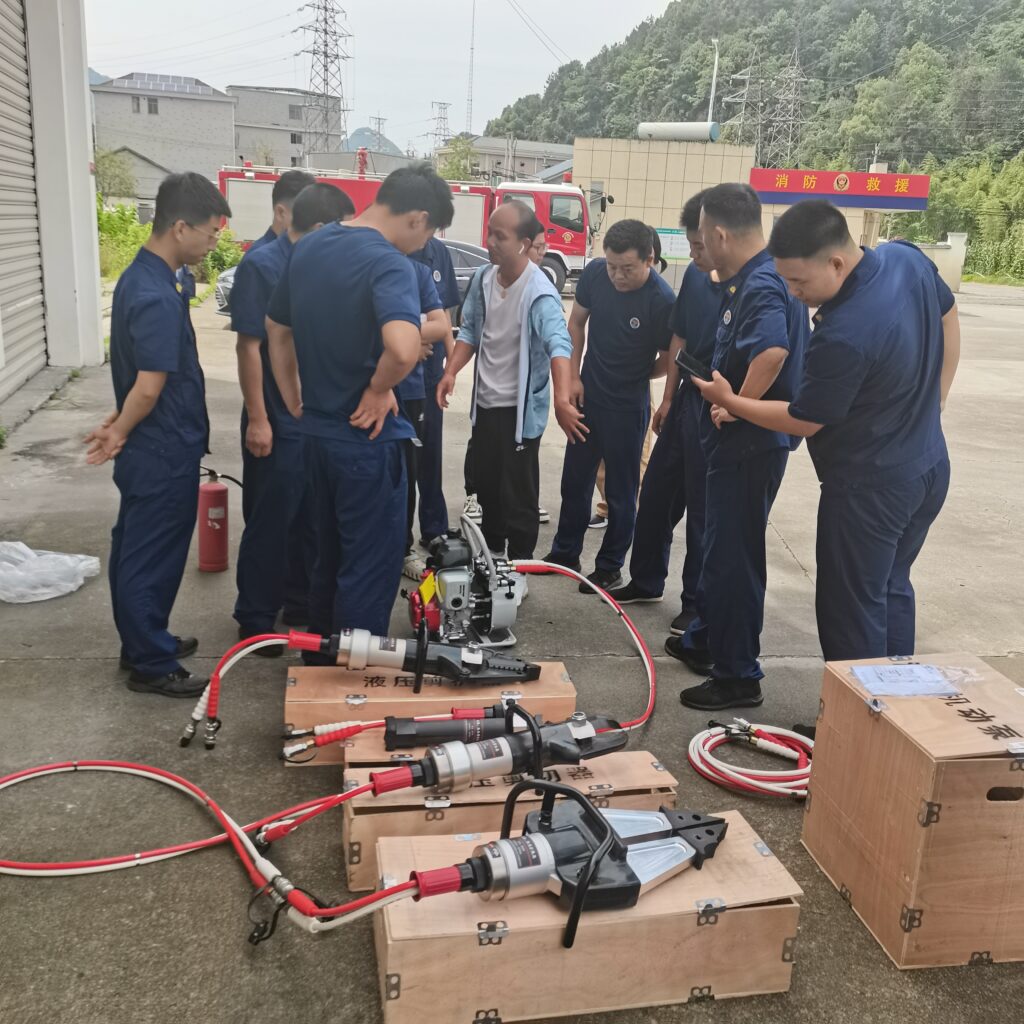our engineers Mr.Wang conducted a training on hydraulic rescue tool sets for a fire rescue team in Hangzhou city,Zhejiang Province On May 19, 2025.we mainly trained the following products:petrol hydraulic pump,rescue combi tool,rescue spreader,rescue cutter,rescue ram.We mainly did the following jobs.
1.preparation stages
1.1 Refueling the petrol hydraulic pump
Petrol hydraulic pump need 3 kinds of oil,engine oil,Hydraulic oil ,Gasoline.
The engine oil has the function of lubricating the engine. Unscrew the oil cap and add 4-stroke engine oil, about 250ml. After adding, tighten the oil cap, loosen the oil cap again, and observe the oil dipstick to determine whether the oil is sufficient. The oil dipstick should normally have 6-8 grids.
The hydraulic oil acts as a medium for transmitting power. There is an oil window in the hydraulic oil tank. Unscrew the oil cap, add about 4L of 10# aviation hydraulic oil, observe the oil window, and fill it to the halfway point of the oil window.
Gasoline is for engine combustion
1.2 Connect rescue equipment
Take out the high-pressure oil hose and connect the hose quick coupler with the motor pump coupler and rescue equipment coupler respectively. One petrol pump can drive two rescue equipment to work at the same time.
1.3 Start the pump
Start the petrol hydraulic pump, adjust the power, then operate the hydraulic rescue equipment
2.Precautions for using hydraulic rescue equipment
1.4 stop operate
After the rescue job is completed, operate the rescue tool and retract the working head of the rescue tool to its original state. Please note that the working head does not need to be completely retracted to prevent the rescue tool from being pressurized. If it lasts for a long time, it may damage the seal of the tool. Turn off the engine and remove the hose coupler.
2.1 Rescue cutter
The root of the cutting blade has the greatest strength, so use the root of the blade for cutting as much as possible. Rescue cutter can be used to cut the A-pillar, B-pillar, C-pillar, and metal structural parts of vehicles. It can also be used to cut steel bars, aluminum, copper bars and other materials. Avoid cutting super-hard materials, such as the drive shaft and crankshaft of vehicles. Cutting hard materials will accelerate the damage of the blade.
2.2 Rescue combi tool
Combi tool have multiple functions, such as cutting, spreading, and pulling. They are widely used in vehicle rescue. Like rescue cutter, the blade root of combi tool has the greatest strength. Using the blade root to cut as much as possible. They can be used to cut metal structures. At the same time, the spreading function can be used to create rescue space. Use the pulling chain for pulling operations.
2.3 Rescue spreader
The hydraulic spreader has spreading, pulling,and traction functions. It has a large opening distance and can tear obstacles and open rescue channels. With the help of the traction chain, it can play a good role in its large traction distance. When using it, first use the tip of spreading head to insert it into a small gap,to spread certain space, then move the spreading head inward to make the spreading force stronger so as to better tear the obstacles.
2.4 Rescue ram
The hydraulic ram can play a supporting role, create rescue space and prevent secondary injuries. When using, the support base should be placed firmly to prevent slipping under force.
3. After-sales maintenance
Keep the tools clean after each use and remove stains, dust, etc. on the surface of the tools.Check the hydraulic oil and engine oil of the petrol pump regularly, and add oil if it is insufficient. Check the rescue tools for oil leakage and repair them in time.
A comprehensive explanation was given on the use and operation methods, operation steps, precautions, maintenance, and usage scenarios, and the rescue tool set was actually operated. All firefighters studied, operated, asked questions, and recorded videos carefully. Our engineers answered the firefighters’ questions carefully. Before this, the firefighters had never operated this type of machine. After one hour of training, the firefighters mastered the use and maintenance skills of the hydraulic rescue tool set. They thanked our engineers, and we will provide technical support at any time during future use. The training was a complete success.

